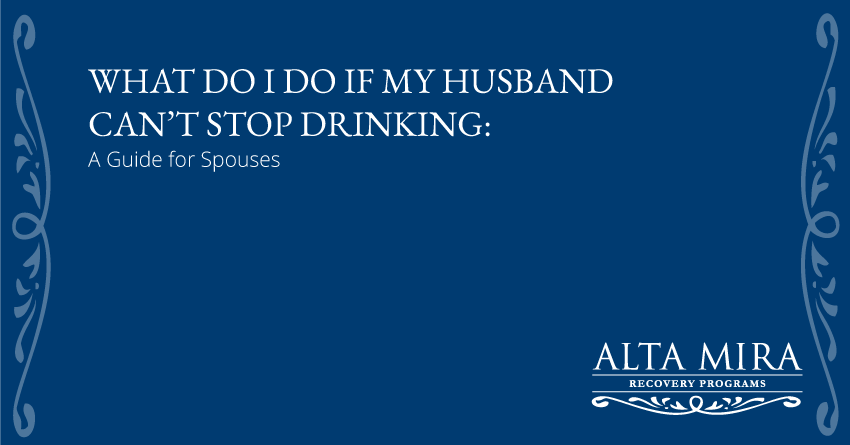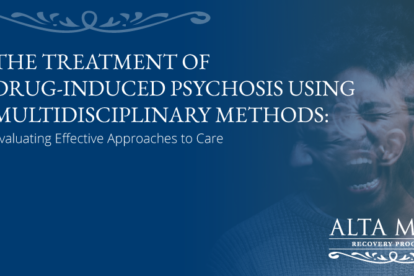
What Should I Do If My Husband Can’t Stop Drinking?
Research from the University of Buffalo, which tracked over 600 couples from the time they applied for marriage licenses through the first nine years of their marriage, highlights the detrimental effects of heavy drinking on marital stability. The study revealed that when one spouse was a heavy drinker while the other was not, the rate of divorce increased to 45%-55% within the first nine years. In contrast, couples where both partners were either heavy drinkers or neither engaged in heavy drinking experienced a lower divorce rate of 30%.
Alta Mira, with their team of experts specializing in addiction recovery, recognizes the profound impact of alcohol use disorder on marital relationships. This guide aims to explore how alcohol dependence can damage relationships and answer the question, “What do I do if my husband can’t stop drinking?”
The Consequences of Living With a Partner with Alcoholism
Alcohol use disorder (AUD) affects millions per year, with statistical evidence of it occurring more in males than females. 16.8 million males compared to 12 million females were diagnosed with AUD in 2023 in the United States alone.
The consequences of living with a partner with alcohol use disorder go beyond the fear of harm happening to their partner physically. A recent survey analyzed data surrounding secondhand harm and alcohol use. Property damage, financial hardships, harassment, and assault were all included in the survey. 21% of women reported experiencing harm from someone else’s drinking, with most reporting against a spouse, partner, or family member.
The psychological impacts of a spouse’s alcohol use also come into question when determining the overall impact of alcohol use disorder on relationships. Studies have highlighted the levels of psychological distress in female spouses of male lifetime at-risk drinkers. The general population noted increasingly higher levels of distress in female spouses than in males.
Research supports the notion that children also experience consequences when a parent is living with an alcohol use disorder. A survey examined adult children of alcoholics (ACOAs) compared to non-ACOAs. The results showed that ACOAs, where the father, mother, or both parents engaged in heavy alcohol use, were more likely to experience parentification, instrumental caregiving, emotional caregiving, and past unfairness during upbringing.

Someone Else’s Alcohol Use Disorder Is Not Personal
Chronic alcohol use is known to induce neurobiological changes, which often shift the affected individual’s focus and diminish attention to familial and financial obligations. A recent study examined the impact of this behavioral shift on the wives and their psychological well-being. The findings revealed that many women experienced profound feelings of guilt, shame, and exclusion. These emotional responses were frequently internalized, reflecting a broader lack of external support from peers and community, even though the women did not have an alcohol use disorder themselves.
Avoid Enabling Alcohol Misuse
A study was conducted on clients with alcohol use disorder and their partners. The results showed significant enabling behavior in three categories:
- Lying to cover their partner’s drinking: the spouses indicated they would lie or hide their partner’s behaviors so others would not know about alcohol use.
- Responsibility shifts: spouses would take over chores and daily responsibilities while their partners would drink.
- Partaking in use: spouses would drink or use other substances with their partner and encourage continued drinking.
The tool utilized in this study was the Behavioral Enabling Scale, and higher scores resulted in a higher need for behavioral intervention. Treating alcohol use disorder in the client was more difficult with an enabling partner, showing the need for treatment options for both.
Taking Care of Yourself
A study highlighted various coping mechanisms wives used while living with a spouse with alcohol use disorder. Of the methods, self-care and emotion-focused coping were the two most utilized. Self-care tactics included seeking counseling, setting boundaries, and focusing on their own health. Emotion-focused coping methods included utilizing hobbies, turning to religion or prayer, and seeking emotional support. The wives in the study also mentioned the importance of taking care of themselves, as they were not able to help their husbands when not feeling their best.
Learn About Alcohol Use Disorder
A method for wives to learn about alcohol use disorder and gain insight into their husband’s behaviors involves conducting research. The National Institute on Alcohol Abuse and Alcoholism (NIAAA) offers various resources discussing alcohol use disorders including discussing the negative health effects, research studies, and information for help.
Seeking knowledge about alcohol use disorder provides insight into behaviors and gives peace of mind to wives. Researching treatment facilities where both partners receive care improves outcomes. The alcohol use disorder program at Alta Mira provides this level of care, ensuring both spousal partners receive accurate and compassionate treatment.
Talking to Your Partner About Drinking
In a recent study, data was compared showing husbands who consume alcohol and wives’ perceptions of their spouse’s consumption. Husbands reported high levels of drinking factors based on the Alcohol Use Disorders Identification Test (AUDIT) while wives reported high levels of perceived problem drinking. Despite these results, few marital adjustments were made. This further supports the evidence above involving enabling behavior – At Alta Mira, we believe that not talking about drinking is another form of enabling the situation.
Does Your Husband Drink Too Much?
When an Intervention Can Help Your Partner
An intervention is a structured and carefully planned process designed to address the partner’s alcohol use in a controlled and supportive environment. Such interventions involve close family members, loved ones, and professional interventionists, who work collaboratively to guide the process. The key stages of an intervention include formulating a detailed plan, gathering relevant information about the individual’s behavior and circumstances, determining the participants, selecting desired outcomes, and documenting the proceedings. The intervention itself is followed by continuous monitoring and follow-up efforts to ensure long-term effectiveness. Involving a professional interventionist is crucial at Alta Mira, as it helps maintain focus, steer the conversation constructively, and de-escalate tensions should the situation become volatile.

Treatment for Alcohol Use Disorder at Alta Mira
It’s well-proven that having a partner with an alcohol use disorder puts strain on the relationship for both parties involved. The good news is there are treatment options available that will help both partners in their recovery journey. Alcoholism treatment will entail multiple levels of therapy, including family and individual sessions to begin the healing process. This is crucial for the marriage to remain intact as both partners will work through their intimate feelings together.
The expert team at Alta Mira understands the importance of both partners receiving care during alcohol use disorder treatment. Through multidisciplinary facets, we address all areas surrounding alcohol use and how it began. Our holistic approach focuses on healing from within to begin living alcohol-free. Call us today at 866-922-1350 to get started with alcohol use disorder treatment.
Alta Mira: Science-backed treatment, world-class care.
Sources
National Institute on Alcohol Abuse and Alcoholism (NIAAA) | National Institute on Alcohol Abuse and Alcoholism (NIAAA), https://www.niaaa.nih.gov/. Accessed 25 September 2024.
“Alcohol Use Disorder (AUD) in the United States: Age Groups and Demographic Characteristics.” National Institute on Alcohol Abuse and Alcoholism (NIAAA), https://www.niaaa.nih.gov/alcohols-effects-health/alcohol-topics/alcohol-facts-and-statistics/alcohol-use-disorder-aud-united-states-age-groups-and-demographic-characteristics. Accessed 25 September 2024.
Duncan, Randy. “Psychological distress among female spouses of male at-risk drinkers.” PubMed, https://pubmed.ncbi.nlm.nih.gov/17157719/. Accessed 25 September 2024.
“Exploring effective coping strategies for wives living with spouses who have alcohol dependence: Insights from focus group discussions.” NCBI, 26 February 2024, https://www.ncbi.nlm.nih.gov/pmc/articles/PMC10977641/. Accessed 25 September 2024.
“Intervention: Help a loved one overcome addiction.” Mayo Clinic, 29 November 2023, https://www.mayoclinic.org/diseases-conditions/mental-illness/in-depth/intervention/art-20047451. Accessed 25 September 2024.
“Parentification and family responsibility in the family of origin of adult children of alcoholics.” PubMed, https://pubmed.ncbi.nlm.nih.gov/16839693/. Accessed 25 September 2024.
Rodriguez, Lindsey M., and Clayton Neighbors. “An Interdependent Look at Perceptions of Spousal Drinking Problems and Marital Outcomes.” NCBI, https://www.ncbi.nlm.nih.gov/pmc/articles/PMC4554974/. Accessed 25 September 2024.
Rotunda, Rob J., et al. “Enabling behavior in a clinical sample of alcohol-dependent clients and their partners.” Journal of Substance Abuse Treatment, 06 2004, https://www.sciencedirect.com/science/article/pii/S074054720400011X.
White, Aaron M. “Gender Differences in the Epidemiology of Alcohol Use and Related Harms in the United States.” Alcohol Research: Current Reviews, 29 October 2020, https://arcr.niaaa.nih.gov/volume/40/2/gender-differences-epidemiology-alcohol-use-and-related-harms-united-states. Accessed 25 September 2024.
Wilde, Cathy. “Heavy drinking is bad for marriage if one spouse drinks, but not both.” University at Buffalo, 21 November 2013, https://www.buffalo.edu/cria/news_events/latest_news.host.html/content/shared/university/news/news-center-releases/2013/11/031.detail.html. Accessed 25 September 2024.






